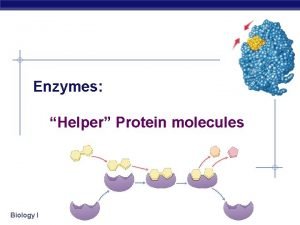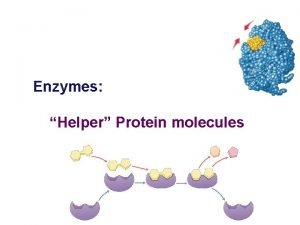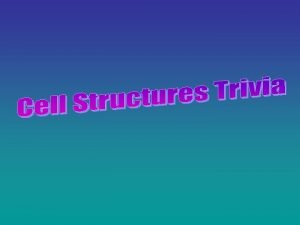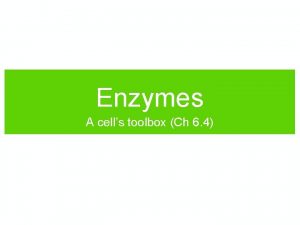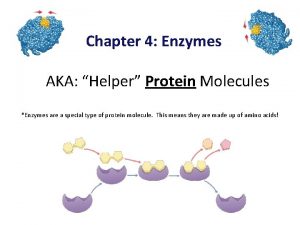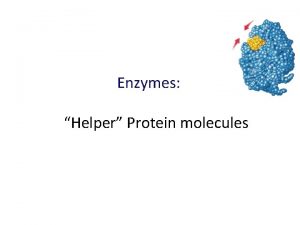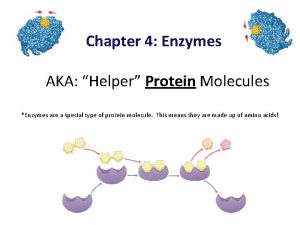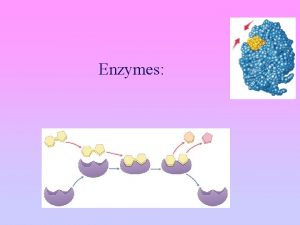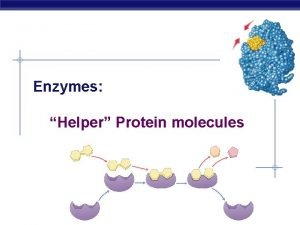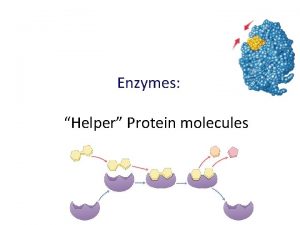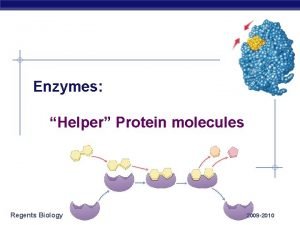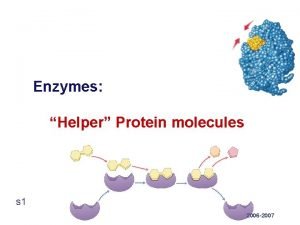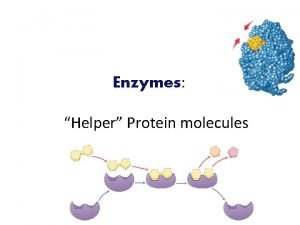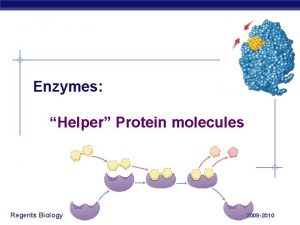Enzymes Helper Protein molecules Nothing works without enzymes














- Slides: 14

Enzymes: “Helper” Protein molecules

Nothing works without enzymes! • How important are enzymes? – all chemical reactions in living organisms require enzymes to work • Chemical reaction: A process in which atoms or molecules rearrange themselves to form a new substance – enzymes speed up reactions • “catalysts” –help the reaction proceed, but are not permanently changed in the process

Enzymes • A protein catalyst • Enzymes are important proteins found in living things. An enzyme is a protein that changes the rate of a chemical reaction. • They speed metabolic reactions.

How do enzymes Work? Enzymes work by weakening bonds which lowers activation energy 4

Enzymes Without Enzyme With Enzyme Free Energy Free energy of activation Reactants Products Progress of the reaction 5

Enzymes aren’t used up • Enzymes are not changed by the reaction – used only temporarily – re-used again for the same reaction with other molecules – very little enzyme needed to help in many reactions substrate active site product enzyme

Enzymes are proteins • Each enzyme is the specific helper to one specific reaction – each enzyme needs to be the right shape for the job – enzymes are named for the reaction they help • • sucrase breaks down sucrose proteases breakdown proteins lipases breakdown lipids DNA polymerase builds DNA

Enzyme vocabulary • Enzyme – helper protein molecule • Substrate – molecule that enzymes work on • Products – what the enzyme helps produce from the reaction • Active site – part of enzyme that substrate molecule fits into

What affects enzyme action • Concentration – More reactants = more collisions and reactions

Temperature • Effect on rates of enzyme activity – Optimum temperature • greatest number of collisions between enzyme & substrate • human enzymes work in the range of 35°to 40°C (body temp = 37°C) – Raise temperature (boiling) • denature protein = unfold = lose shape – Lower temperature T° • molecules move slower • fewer collisions between enzyme & substrate

Temperature reaction rate human enzymes 37° temperature What’s happening here? !

p. H • Effect on rates of enzyme activity – changes in p. H changes protein shape~ Denatures – most human enzymes = p. H 6 -8 • depends on where in body • pepsin (stomach) = p. H 3 • trypsin (small intestines) = p. H 8

What’s happening here? ! p. H Average enzymes Intestines reaction rate stomach 0 1 2 3 4 5 6 p. H 7 8 9 10 11 12 13 14

For enzymes… What matters? SHAPE!
 Nothing but nothing leaves nothing
Nothing but nothing leaves nothing Helper protein molecule
Helper protein molecule Helper protein molecule
Helper protein molecule Organic molecules vs inorganic molecules
Organic molecules vs inorganic molecules Preparation of protein molecules for cellular exportation
Preparation of protein molecules for cellular exportation Chapter 12 enzymes the protein catalyst
Chapter 12 enzymes the protein catalyst Nothing venture nothing have
Nothing venture nothing have The way he talks
The way he talks Alesha dixon boy does nothing
Alesha dixon boy does nothing Nothing ventured nothing gained origin
Nothing ventured nothing gained origin Protein pump vs protein channel
Protein pump vs protein channel Protein-protein docking
Protein-protein docking Safety at street works and road works pdf
Safety at street works and road works pdf Without vocabulary nothing can be conveyed
Without vocabulary nothing can be conveyed Ezekiel 14:23
Ezekiel 14:23

